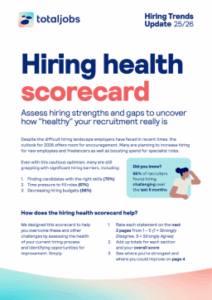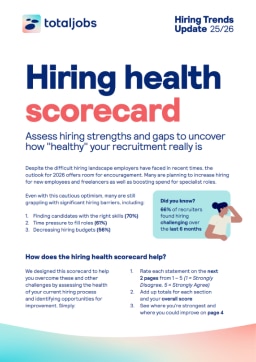
5 common hiring challenges facing small businesses
Table of Contents
- Key takeaways
- 1. Shrinking hiring budgets
- 2. Finding skilled candidates
- 3. Meeting candidate expectations
- 4. Lengthy hiring processes
- 5. Attracting diverse applicants
- Challenge to strategic advantage
- FAQs

Hiring Health Scorecard
The 5.5 million small or medium sized businesses (SMBs) in the UK in 2024 represented over 99% of the business population. However, they face varied and significant hiring challenges that can hamper growth.
In this article, we’ll be exploring the hiring challenges small businesses face, with practical advice on how to overcome them.
Key takeaways
- 46% of small businesses are dealing with reduced recruitment budgets
- 66% of SMBs struggle to find candidates with the right skills
- Almost half of SMBs struggle to meet salary and flexibility expectations
- 41% of SMBs struggle to attract diverse applicants for open roles
- Poor candidate experience and slow hiring contribute to high dropout rates
1. Shrinking hiring budgets
Totaljobs research found that 46% of small businesses report challenges related to reduced hiring budgets.
When budgets tighten, small businesses are often faced with:
- Limited ability to advertise roles across multiple platforms
- Operating with little or no dedicated recruitment support
- Pauses or delays in hiring, even for key, business critical positions
These pressures not only slow down hiring but can also impact the quality of candidates sourced, putting small businesses at a disadvantage in a competitive market.
Prioritise ROI
To really make every pound in their hiring budget count, smaller businesses should look to focus on maximising their return on investment (ROI).
There are several ways this can be achieved, including:
- Leveraging low-cost recruitment channels: Making the most of employee referrals, boomerang employees, and local networks to reach relevant, high-quality candidates without overspending.
- Building a strong employer brand organically: Strategies like sharing authentic employee stories and highlighting organisational culture on social media can be a cost-effective way to attract talent.
- Tracking metrics that matter: Measuring key recruitment KPIs like cost per hire, quality of hire, and retention rates can help to ensure recruitment spend is aligned to results.
2. Finding candidates with the right skills
Identifying candidates with the skills they need is a challenge for 66% of SMBs. This is compounded by the fact that 51% report difficulties related to increasing skills requirements for open roles.

Skills shortages won’t solve themselves, especially in fast-evolving sectors like AI, where the market can’t produce experienced talent quickly enough. To stay ahead, employers should invest for the long term by hiring for potential, bringing in people with transferable skills and upskilling them to bridge gaps. This not only builds capability but also fosters loyalty and long-term performance.
Bianca Stringuini, Global Inclusion Lead, The Stepstone Group
Widening skills gaps also make it harder, particularly for small businesses, to fill positions efficiently, often resulting in:
- Roles remaining vacant for longer than planned
- Increased workload and potentially burnout for existing employees
- Hiring candidates who only partially meet requirements
Broaden searches and rethink job requirements
To address skills sourcing challenges, small businesses can adopt smarter, more flexible approaches to identifying and evaluating talent in the recruitment process.
This can take many forms, including, but not limited to:
- Rethinking job requirements: Focusing on the skills and potential needed to perform in each role, as opposed to rigid education or experience criteria, opening up the candidate pool and reducing hiring delays.
- Exploring transferable skills: Consider candidates from other roles or industries who may bring valuable capabilities. For example, a customer service advisor may have strong communication and time management skills that translate into a sales support or account coordination role.
- Implement skills-based hiring: With 80% of SMBs expecting skills-based hiring to be a priority moving forward, adopting a more skills-focused approach is one of the most effective ways to broaden talent pools and find candidates with the right skills.
3. Meeting candidate expectations
Candidate expectations are constantly evolving, making it especially difficult for small and medium sized employers to meet demand.
We found that 49% of SMBs struggle to meet salary expectations, while 48% face challenges offering the flexible working arrangements candidates now expect. This is significant, as 72% of candidates say they would consider leaving their job if it didn’t support flexible working.
When it comes to what attracts candidates most, their top priorities include:
- Salary (54%)
- Work–life balance (38%)
- Job security (28%)
From an employer’s perspective, failing to meet candidate expectations can lead to applicants withdrawing from processes and lower offer acceptance rates, making recruitment cycles longer and more resource intensive.
Compete with more than just pay
Employers won’t always be able to match candidate’s expectations when it comes to compensation. But that doesn’t mean they need to miss out on top talent.
Organisations that don’t have the budgets to provide salary and benefit packages over and above industry benchmarks can still stand out by focusing on their unique strengths. For example:
- Emphasise culture and purpose: Showcase the organisation’s values, mission, and sense of community, qualities that often matter more to candidates seeking meaningful work.
- Highlight flexibility creatively: If fully remote work isn’t an option, offer flexible hours, compressed weeks, or hybrid options where feasible.
- Promote growth and learning: Communicate clear career paths, mentoring, succession, and skill development opportunities to attract ambitious candidates.
- Be transparent and authentic: Clearly outline what the organisation can offer and why it’s a great place to grow. Transparency not only builds trust but can directly impact candidate engagement, with 39% of applicants more likely to stay in a process when roles and expectations are clearly explained.
4. Lengthy hiring processes
A lengthy time to hire causes issues for organisations of every size, with SMBs in particular facing challenges related to hiring speed:
- 53% feel under pressure to fill open roles quickly
- 49% report lengthy hiring processes as a barrier to securing talent
A slow recruitment process can also cause reputational damage, with 86% of candidates saying they’re less likely to accept an offer from an employer with a poor hiring experience. 28% of candidates drop out of hiring processes altogether, often due to a lack of transparency around:
- Role requirements (39%)
- Salary (35%)
- Unclear expectations (34%)
- Slow feedback and delays (34%)
Streamline recruitment
Revisiting recruitment structures and processes is key to reducing the time it takes to onboard talent.
Some of the steps small businesses can take to improve both time-to-hire and the overall candidate experience include:
- Simplifying processes: Eliminate unnecessary interview stages or complex assessments to maintain focus and speed things up.
- Utilise automation: Implement tools, including artificial intelligence (AI), to help with screening, scheduling and note taking.
- Set clear timelines: Align internally on each stage of the process and communicate this clearly to candidates.
5. Attracting diverse applicants
A diverse workplace breeds innovation, in addition to enhancing problem solving and helping to build better connections with stakeholders. As a result, diversity shouldn’t just be seen as a moral imperative, but a potential competitive advantage.
However, as many as 41% of SMB’s say they struggle to attract applicants from diverse backgrounds when hiring for open roles. This lack of diversity can cause:
- A narrower range of perspectives and ideas within teams
- Difficulty appealing to wider customer demographics
Embed inclusion into the hiring process
Creating inclusive hiring practices doesn’t require a large budget. It’s about awareness, intent, and consistency. Small businesses can start by:
- Using inclusive language in job descriptions and focusing on essential skills to avoid unintentionally excluding candidates.
- Using their website and social media channels to highlight real stories and initiatives that promote belonging.
- Provide basic unconscious bias training to create a fairer, more inclusive recruitment process.
- Tracking the diversity of applicants and hires to ensure inclusion efforts are having a measurable impact.

A diverse workforce, with varied lived experiences that reflect the customer base, is crucial for modern businesses. If the people designing products, testing services, or engaging with customers can’t relate to their perspectives, there’s a real risk that offerings will miss the mark entirely. Diversity of thought leads to solutions that truly resonate.
Bianca Stringuini, Global Inclusion Lead, The Stepstone Group
Turning hiring challenges into strategic advantages
With rising candidate expectations and 28% dropping out of hiring processes, small businesses can’t afford to rely on outdated recruitment techniques. By adopting a skills-based approach, working to strengthen their employer brand and embedding transparency and inclusion into their processes, smaller employers can work to turn these hurdles into opportunities, establishing a competitive advantage in the process.
Frequently asked questions (FAQs)
What are the biggest hiring challenges small businesses face in 2026?
The most common hiring challenges for small businesses include limited recruitment budgets, difficulty finding skilled candidates, meeting salary and flexibility expectations, lengthy hiring processes, and attracting diverse applicants.
How can small businesses maximise their recruitment ROI?
SMBs can improve hiring ROI by using low-cost recruitment channels like referrals, building a strong employer brand on social media, and tracking metrics such as cost per hire and retention to ensure every hire delivers value.
How can small businesses overcome skills shortages when hiring?
Employers can address skills gaps by hiring for potential, focusing on transferable skills, and implementing skills-based hiring to identify candidates with the right abilities, even if their experience isn’t a perfect match.
How can small businesses attract talent when they can’t compete on salary?
They can focus on culture, purpose, flexibility, and career growth. Highlighting authentic stories, development opportunities, and meaningful work helps SMBs appeal to candidates seeking more than just higher pay.
Why is attracting diverse applicants important for small businesses?
Diverse teams bring varied perspectives that foster innovation and improve problem-solving. Yet 41% of SMBs struggle to attract diverse applicants, limiting their ability to reach broader markets and customer groups.
Explore articles
Receive the latest recruitment resources and
advice to boost your hiring
By providing us with your details you agree to our privacy policy and for us to keep you updated with the latest news, events,
and special offers from Totaljobs.










